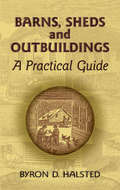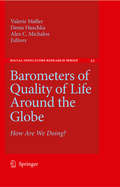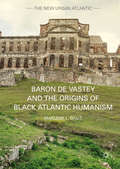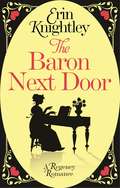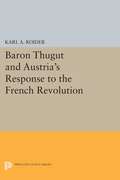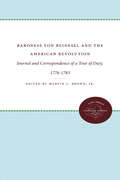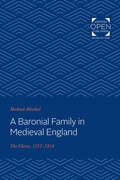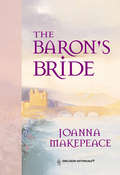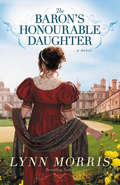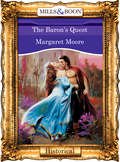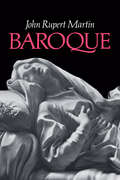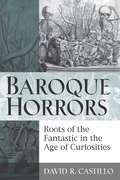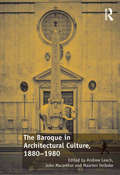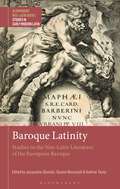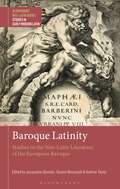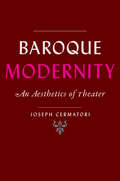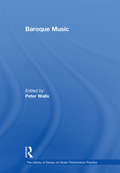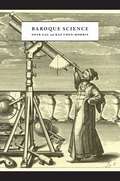- Table View
- List View
Barns, Sheds and Outbuildings: A Practical Guide
by Byron D. HalstedAccompanied by more than 250 illustrations, Halsted's environmentally sensitive manual was written with the farmer in mind — and during a time when a laborer earned a mere dollar a day. His barn-building theories extend to dog- and bird-houses, and are based upon qualities we still hold dear: light and air, space, cost, and beauty, as well as permanence, convenience, and workability.This facsimile edition of the 1881 book of plans and instructions will engage the reader with its anecdotal style. Nearly 100 structures span the gamut of farm buildings: from monumental barns--four stories high and covering nearly an acre, to lowly hen coops and root cellars. The particulars of their construction, recounted in simple and practical terms, tell a timeless tale of life lived amid the changing seasons and the natural world.
Barometers of Quality of Life Around the Globe: How Are We Doing? (Social Indicators Research Series #33)
by Denis Huschka Alex C. Michalos Valerie MøllerQuality of life (QOL) research has made great strides since the social indicator movement started as a scientific enterprise in the 1960s. Following the lead of pioneers in North America and Europe, social scientists in other regions of the world have adopted and refined social data systems or barometers to monitor progress in enhancing the welfare and well-being of citizens. A distinctive feature of these barometers is that they measure both individual and societal quality of life. While not overlooking the more basic needs and material standards of living, the barometers also inform on issues of individual freedoms and choices and constraints on citizen empowerment that enhance and depress quality of life. Designed to capture nuances in local definitions of the good life, regional barometers are unique expressions of the obstacles facing different societies in their quest to achieve the good life. Scholars of public policy as well as policy makers will find inspiration from reviews of innovative initiatives to monitor contemporary quality of life in six regions of the world spanning South America, the Arctic, Europe, Africa, Asia, and Australia.
Baron de Vastey and the Origins of Black Atlantic Humanism (The New Urban Atlantic)
by Marlene L. DautFocusing on the influential life and works of the Haitian political writer and statesman, Baron de Vastey (1781-1820), in this book Marlene L. Daut examines the legacy of Vastey’s extensive writings as a form of what she calls black Atlantic humanism, a discourse devoted to attacking the enlightenment foundations of colonialism. Daut argues that Vastey, the most important secretary of Haiti’s King Henry Christophe, was a pioneer in a tradition of deconstructing colonial racism and colonial slavery that is much more closely associated with twentieth-century writers like W.E.B. Du Bois, Frantz Fanon, and Aimé Césaire. By expertly forging exciting new historical and theoretical connections among Vastey and these later twentieth-century writers, as well as eighteenth- and nineteenth-century black Atlantic authors, such as Phillis Wheatley, Olaudah Equiano, William Wells Brown, and Harriet Jacobs, Daut proves that any understanding of the genesis of Afro-diasporic thought must include Haiti’s Baron de Vastey.
The Baron Next Door: A Regency Romance (Prelude to a Kiss #1)
by Erin KnightleyAfter an exhausting Season spent at the mercy of the whispering Ton, Bath's first annual music festival offers Charity the perfect escape: freedom to indulge her true passion and play the pianoforte to her heart's content. That is, until their insufferably rude, though undeniably handsome, neighbour tells her to keep the "infernal racket" to a minimum.Hugh Danby, Baron Cadgwith, is in Bath to heal hidden wounds, both mental and physical. He may think he's finally put an end to the noise next door, but he has no idea what he's begun. The more he discovers about Charity, the more he finds her bothersome, vexing, and . . . inexplicably enchanting. Before long, Hugh suspects that even if his body heals, it's his heart that might end up broken."Charmingly sweet and tender..." -Publishers Weekly"One of the most beautifully crafted romances I've read in years.' - Jillian Hunter"Charming, sensitive, and compassionate, this tale is Knightley at her best." -RT Book Reviews, 4½ stars"This sweet treat of a romance will entrance you with its delicious humor and delectable characters." -Sabrina Jeffries
Baron Thugut and Austria's Response to the French Revolution (PDF)
by Karl A. Roider Jr.Here is the first political biography of Baron Franz Maria Thugut, the principal Austrian opponent of the French Revolution. This work explains Thugut's role as the first Austrian statesman seriously to confront the Revolution. In the process it makes significant revisions in the conventional picture of the international system of the period.Originally published in 1987.The Princeton Legacy Library uses the latest print-on-demand technology to again make available previously out-of-print books from the distinguished backlist of Princeton University Press. These editions preserve the original texts of these important books while presenting them in durable paperback and hardcover editions. The goal of the Princeton Legacy Library is to vastly increase access to the rich scholarly heritage found in the thousands of books published by Princeton University Press since its founding in 1905.
Baroness von Riedesel and the American Revolution: Journal and Correspondence of a Tour of Duty, 1776-1783 (Published by the Omohundro Institute of Early American History and Culture and the University of North Carolina Press)
by Marvin L. BrownThese journal accounts and letters form one of the most engaging and readable accounts of the American Revolution. Written with directness, simplicity, and charm by the wife of the commanding general of Brunswick troops in the British army, the narrative reveals the conditions in revolutionary America.Originally published in 1965.A UNC Press Enduring Edition -- UNC Press Enduring Editions use the latest in digital technology to make available again books from our distinguished backlist that were previously out of print. These editions are published unaltered from the original, and are presented in affordable paperback formats, bringing readers both historical and cultural value.
A Baronial Family in Medieval England: The Clares, 1217-1314 (The Johns Hopkins University Studies in Historical and Political Science #2)
by Michael AltschulIn A Baronial Family in Medieval England: The Clares, 1217–1314, Michael Altschul studies the Clare family during the thirteenth century. The Clares spearheaded the struggle to enforce Magna Carta in the Barons' War. Historians prior to Altschul tended to neglect the Clares' history given the scattered nature of the archives documenting their time as a politically influential and powerful family. This book unfolds chronologically, outlining the Clares' rise to preeminence and describing how they administered their estates and income.
A Baronial Family in Medieval England: The Clares, 1217-1314 (The Johns Hopkins University Studies in Historical and Political Science #2)
by Michael AltschulOriginally published in 1965. In A Baronial Family in Medieval England: The Clares, 1217–1314, Michael Altschul studies the Clare family during the thirteenth century. The Clares spearheaded the struggle to enforce Magna Carta in the Barons' War. Historians prior to Altschul tended to neglect the Clares' history given the scattered nature of the archives documenting their time as a politically influential and powerful family. This book unfolds chronologically, outlining the Clares' rise to preeminence and describing how they administered their estates and income.
The Baron's Bride (Mills And Boon Historical Ser.)
by Joanna MakepeaceGisela of Brinkhurst enjoyed managing her father's keep and had never thought much about marriage. Little did she foresee the threats to her father's lands and how marriage would ensure their survival.
The Baron's Honourable Daughter: A Novel
by Lynn MorrisBestselling author Lynn Morris weaves an inspirational Regency era romance rich in period detail.When her stepfather suddenly dies, Valeria Segrave finds she must take charge of her grieving mother and the vast estate which now belongs to her six-year-old half brother, the new Earl of Maledon. Though capable, Valeria is frustrated to find each day brings a new struggle as she tries to establish her authority with servants, stewards, and solicitors-all men. As a young woman with no blood relation to the earl, they are all too ready to dismiss her. Much to her chagrin, she must rely on the assistance of her stepfather's distant kinsman, Alastair, Lord Hylton. He is handsome and noble, and Valeria senses under the veneer of his gentlemanly behavior that she never measures up to his expectations of a refined lady. In light of that, accepting his help and feeling under a burden of gratitude to him is almost unbearable. Even when Valeria leaves the country estate for the glittering London Season, where she gets into a series of escapades, Lord Hylton is always there to witness, criticize, and correct her behavior. But if Alastair insists on engaging in a battle of wits and wills with the lively Valeria, she'll stop at nothing to prove that he's met his match.
The Baron's Quest (Mills And Boon Vintage 90s Modern Ser.)
by Margaret MooreThe Baron DeGuerre Had Finally Met His Match Though famed for prowess in tourney and war, Etienne DeGuerre now found himself at odds in the Battle of the Sexes. For his opponent, Gabriella Frechette, was a woman of singular beauty… and single-minded resolve. One who had easily stormed his defenses, and laid siege to his unsuspecting heart
Baroque (Icon Editions Ser.)
by John Rupert MartinThis is a nonchronological introduction to Baroque, one of the great periods of European art. John Martin's descriptions of the essential characteristics of the Baroque help one to gain an understanding of the style. His illustrations are informative and he has clearly looked with a fresh eye at the works of art themselves. In addition to the more than 200 illustrations, the volume contains an appendix of translated documents.
Baroque
by John Rupert MartinThis is a nonchronological introduction to Baroque, one of the great periods of European art. John Martin's descriptions of the essential characteristics of the Baroque help one to gain an understanding of the style. His illustrations are informative and he has clearly looked with a fresh eye at the works of art themselves. In addition to the more than 200 illustrations, the volume contains an appendix of translated documents.
Baroque Horrors: Roots of the Fantastic in the Age of Curiosities
by David Castillo"David Castillo takes us on a tour of some horrific materials that have rarely been considered together. He sheds a fantastical new light on the baroque." ---Anthony J. Cascardi, University of California Berkeley "Baroque Horrors is a textual archeologist's dream, scavenged from obscure chronicles, manuals, minor histories, and lesser-known works of major artists. Castillo finds tales of mutilation, mutation, monstrosity, murder, and mayhem, and delivers them to us with an inimitable flair for the sensational that nonetheless rejects sensationalism because it remains so grounded in historical fact." ---William Egginton, Johns Hopkins University "Baroque Horrors is a major contribution to baroque ideology, as well as an exploration of the grotesque, the horrible, the fantastic. Castillo organizes his monograph around the motif of curiosity, refuting the belief that Spain is a country incapable of organized scientific inquiry." ---David Foster, Arizona State University Baroque Horrors turns the current cultural and political conversation from the familiar narrative patterns and self-justifying allegories of abjection to a dialogue on the history of our modern fears and their monstrous offspring. When life and death are severed from nature and history, "reality" and "authenticity" may be experienced as spectator sports and staged attractions, as in the "real lives" captured by reality TV and the "authentic cadavers" displayed around the world in the Body Worlds exhibitions. Rather than thinking of virtual reality and staged authenticity as recent developments of the postmodern age, Castillo looks back to the Spanish baroque period in search for the roots of the commodification of nature and the horror vacui that accompanies it. Aimed at specialists, students, and readers of early modern literature and culture in the Spanish and Anglophone traditions as well as anyone interested in horror fantasy, Baroque Horrors offers new ways to rethink broad questions of intellectual and political history and relate them to the modern age. David Castillo is Associate Professor and Director of Graduate Studies in the Department of Romance Languages and Literatures at the University at Buffalo, SUNY. Jacket art: Frederick Ruysch's anatomical diorama. Engraving reproduction "drawn from life" by Cornelius Huyberts. Image from the Zymoglyphic Museum.
The Baroque in Architectural Culture, 1880-1980
by Andrew Leach John MacarthurIn his landmark volume Space, Time and Architecture, Sigfried Giedion paired images of two iconic spirals: Tatlin’s Monument to the Third International and Borromini’s dome for Sant’Ivo alla Sapienza. The values shared between the baroque age and the modern were thus encapsulated on a single page spread. As Giedion put it, writing of Sant’Ivo, Borromini accomplished 'the movement of the whole pattern [...] from the ground to the lantern, without entirely ending even there.' And yet he merely 'groped' towards that which could 'be completely effected' in modern architecture-achieving 'the transition between inner and outer space.' The intellectual debt of modern architecture to modernist historians who were ostensibly preoccupied with the art and architecture of earlier epochs is now widely acknowledged. This volume extends this work by contributing to the dual projects of the intellectual history of modern architecture and the history of architectural historiography. It considers the varied ways that historians of art and architecture have historicized modern architecture through its interaction with the baroque: a term of contested historical and conceptual significance that has often seemed to shadow a greater contest over the historicity of modernism. Presenting research by an international community of scholars, this book explores through a series of cross sections the traffic of ideas between practice and history that has shaped modern architecture and the academic discipline of architectural history across the long twentieth century. The editors use the historiography of the baroque as a lens through which to follow the path of modern ideas that draw authority from history. In doing so, the volume defines a role for the baroque in the history of architectural historiography and in the history of modern architectural culture.
The Baroque in Architectural Culture, 1880-1980
by Andrew Leach John MacarthurIn his landmark volume Space, Time and Architecture, Sigfried Giedion paired images of two iconic spirals: Tatlin’s Monument to the Third International and Borromini’s dome for Sant’Ivo alla Sapienza. The values shared between the baroque age and the modern were thus encapsulated on a single page spread. As Giedion put it, writing of Sant’Ivo, Borromini accomplished 'the movement of the whole pattern [...] from the ground to the lantern, without entirely ending even there.' And yet he merely 'groped' towards that which could 'be completely effected' in modern architecture-achieving 'the transition between inner and outer space.' The intellectual debt of modern architecture to modernist historians who were ostensibly preoccupied with the art and architecture of earlier epochs is now widely acknowledged. This volume extends this work by contributing to the dual projects of the intellectual history of modern architecture and the history of architectural historiography. It considers the varied ways that historians of art and architecture have historicized modern architecture through its interaction with the baroque: a term of contested historical and conceptual significance that has often seemed to shadow a greater contest over the historicity of modernism. Presenting research by an international community of scholars, this book explores through a series of cross sections the traffic of ideas between practice and history that has shaped modern architecture and the academic discipline of architectural history across the long twentieth century. The editors use the historiography of the baroque as a lens through which to follow the path of modern ideas that draw authority from history. In doing so, the volume defines a role for the baroque in the history of architectural historiography and in the history of modern architectural culture.
Baroque Latinity: Studies in the Neo-Latin Literature of the European Baroque (Bloomsbury Neo-Latin Series: Studies in Early Modern Latin)
by Jacqueline Glomski, Gesine Manuwald and Andrew TaylorThis volume addresses the idea of the Baroque in European literature in Latin. With contributions by scholars from various disciplines and countries, and by looking at a range of texts from across Europe, the volume offers case studies to deepen scholarly understanding of this important literary phenomenon and inspire future research. A key aim of the volume is to address the distinctiveness of these texts by interrogating the usefulness and specificity of the term 'Baroque', especially in relation to the classical rules it transgresses to produce effects of grandeur, richness, and exuberance in a range of secular and sacred arts (e.g. music, architecture, painting), as well as various forms of literature (e.g. prose, poetry, drama). The contributors consider how and why Latin writing mutated from earlier humanist paradigms, thus exploring how ideas of 'early modern' and 'Baroque' are related, and examine the interplay of the theory and practice of the 'Baroque', including its debts to and deviations from ancient models, and its limits and limitations.
Baroque Latinity: Studies in the Neo-Latin Literature of the European Baroque (Bloomsbury Neo-Latin Series: Studies in Early Modern Latin)
This volume addresses the idea of the Baroque in European literature in Latin. With contributions by scholars from various disciplines and countries, and by looking at a range of texts from across Europe, the volume offers case studies to deepen scholarly understanding of this important literary phenomenon and inspire future research. A key aim of the volume is to address the distinctiveness of these texts by interrogating the usefulness and specificity of the term 'Baroque', especially in relation to the classical rules it transgresses to produce effects of grandeur, richness, and exuberance in a range of secular and sacred arts (e.g. music, architecture, painting), as well as various forms of literature (e.g. prose, poetry, drama). The contributors consider how and why Latin writing mutated from earlier humanist paradigms, thus exploring how ideas of 'early modern' and 'Baroque' are related, and examine the interplay of the theory and practice of the 'Baroque', including its debts to and deviations from ancient models, and its limits and limitations.
Baroque Modernity: An Aesthetics of Theater (Hopkins Studies in Modernism)
by Joseph CermatoriA groundbreaking study on the vital role of baroque theater in shaping modernist philosophy, literature, and performance.Winner, Helen Tartar First Book Subvention AwardBaroque style—with its emphasis on ostentation, adornment, and spectacle—might seem incompatible with the dominant forms of art since the Industrial Revolution, but between 1875 and 1935, European and American modernists connected to the theater became fascinated with it. In Baroque Modernity, Joseph Cermatori argues that the memory of seventeenth-century baroque stages helped produce new forms of theater, space, and experience around the turn of the twentieth century. In response, modern theater helped give rise to the development of the baroque as a modern philosophical idea. The book focuses on avant-gardists whose writing takes place between theory and performance: philosophical theater-makers and theatrical philosophers including Friedrich Nietzsche, Stéphane Mallarmé, Walter Benjamin, and Gertrude Stein. Moving between page and stage, this study tracks the remnants of seventeenth-century theater through modernist aesthetics across an array of otherwise disparate materials, including modern opera, Bertolt Brecht's Epic Theater, poetic tragedies, and miracle plays. By reexamining the twentieth century's engagements with Gianlorenzo Bernini, William Shakespeare, Claudio Monteverdi, Calderón de la Barca, and other seventeenth-century predecessors, the book delineates an enduring tradition of baroque performance. Along the way, Cermatori expands our familiar narratives of "the modern" and traces a history of theatricality that reverberates into the twenty-first century. Baroque Modernity will appeal to readers in a wide array of disciplines, including comparative literature, theater and performance, art and music history, intellectual history, and aesthetic theory.
Baroque Modernity: An Aesthetics of Theater (Hopkins Studies in Modernism)
by Joseph CermatoriA groundbreaking study on the vital role of baroque theater in shaping modernist philosophy, literature, and performance.Winner, Helen Tartar First Book Subvention AwardBaroque style—with its emphasis on ostentation, adornment, and spectacle—might seem incompatible with the dominant forms of art since the Industrial Revolution, but between 1875 and 1935, European and American modernists connected to the theater became fascinated with it. In Baroque Modernity, Joseph Cermatori argues that the memory of seventeenth-century baroque stages helped produce new forms of theater, space, and experience around the turn of the twentieth century. In response, modern theater helped give rise to the development of the baroque as a modern philosophical idea. The book focuses on avant-gardists whose writing takes place between theory and performance: philosophical theater-makers and theatrical philosophers including Friedrich Nietzsche, Stéphane Mallarmé, Walter Benjamin, and Gertrude Stein. Moving between page and stage, this study tracks the remnants of seventeenth-century theater through modernist aesthetics across an array of otherwise disparate materials, including modern opera, Bertolt Brecht's Epic Theater, poetic tragedies, and miracle plays. By reexamining the twentieth century's engagements with Gianlorenzo Bernini, William Shakespeare, Claudio Monteverdi, Calderón de la Barca, and other seventeenth-century predecessors, the book delineates an enduring tradition of baroque performance. Along the way, Cermatori expands our familiar narratives of "the modern" and traces a history of theatricality that reverberates into the twenty-first century. Baroque Modernity will appeal to readers in a wide array of disciplines, including comparative literature, theater and performance, art and music history, intellectual history, and aesthetic theory.
Baroque Music
by Peter WallsResearch in the 20th and 21st centuries into historical performance practice has changed not just the way performers approach music of the 17th and 18th centuries but, eventually, the way audiences listen to it. This volume, beginning with a 1915 Saint-Sa lecture on the performance of old music, sets out to capture musicological discussion that has actually changed the way Baroque music can sound. The articles deal with historical instruments, pitch, tuning, temperament, the nexus between technique and style, vibrato, the performance implications of musical scores, and some of the vexed questions relating to rhythmic alteration. It closes with a section on the musicological challenges to the ideology of the early music movement mounted (principally) in the 1990s. Leading writers on historical performance practice are represented. Recognizing that significant developments in historically-inspired performance have been led by instrument makers and performers, the volume also contains representative essays by key practitioners.
Baroque Music
by Peter WallsResearch in the 20th and 21st centuries into historical performance practice has changed not just the way performers approach music of the 17th and 18th centuries but, eventually, the way audiences listen to it. This volume, beginning with a 1915 Saint-Sa lecture on the performance of old music, sets out to capture musicological discussion that has actually changed the way Baroque music can sound. The articles deal with historical instruments, pitch, tuning, temperament, the nexus between technique and style, vibrato, the performance implications of musical scores, and some of the vexed questions relating to rhythmic alteration. It closes with a section on the musicological challenges to the ideology of the early music movement mounted (principally) in the 1990s. Leading writers on historical performance practice are represented. Recognizing that significant developments in historically-inspired performance have been led by instrument makers and performers, the volume also contains representative essays by key practitioners.
Baroque Science
by Ofer Gal Raz Chen-MorrisIn Baroque Science, Ofer Gal and Raz Chen-Morris present a radically new perspective on the scientific revolution of the seventeenth century. Instead of celebrating the triumph of reason and rationality, they study the paradoxes and anxieties that stemmed from the New Science and the intellectual compromises that shaped it and enabled its spectacular success. Gal and Chen-Morris show how the protagonists of the new mathematical natural philosophy grasped at the very far and very small by entrusting observation to the mediation of artificial instruments, and how they justified this mediation by naturalizing and denigrating the human senses. They show how the physical-mathematical ordering of heavens and earth demanded obscure and spurious mathematical procedures, replacing the divine harmonies of the late Renaissance with an assemblage of isolated, contingent laws and approximated constants. Finally, they show how the new savants, forced to contend that reason is hopelessly estranged from its surrounding world and that nature is irreducibly complex, turned to the passions to provide an alternative, naturalized foundation for their epistemology and ethics. Enforcing order in the face of threatening chaos, blurring the boundaries of the natural and the artificial, and mobilizing the passions in the service of objective knowledge, the New Science, Gal and Chen-Morris reveal, is a Baroque phenomenon: deeply entrenched in and crucially formative of the culture of its time.
Baroque Science
by Ofer Gal Raz Chen-MorrisIn Baroque Science, Ofer Gal and Raz Chen-Morris present a radically new perspective on the scientific revolution of the seventeenth century. Instead of celebrating the triumph of reason and rationality, they study the paradoxes and anxieties that stemmed from the New Science and the intellectual compromises that shaped it and enabled its spectacular success. Gal and Chen-Morris show how the protagonists of the new mathematical natural philosophy grasped at the very far and very small by entrusting observation to the mediation of artificial instruments, and how they justified this mediation by naturalizing and denigrating the human senses. They show how the physical-mathematical ordering of heavens and earth demanded obscure and spurious mathematical procedures, replacing the divine harmonies of the late Renaissance with an assemblage of isolated, contingent laws and approximated constants. Finally, they show how the new savants, forced to contend that reason is hopelessly estranged from its surrounding world and that nature is irreducibly complex, turned to the passions to provide an alternative, naturalized foundation for their epistemology and ethics. Enforcing order in the face of threatening chaos, blurring the boundaries of the natural and the artificial, and mobilizing the passions in the service of objective knowledge, the New Science, Gal and Chen-Morris reveal, is a Baroque phenomenon: deeply entrenched in and crucially formative of the culture of its time.
Baroque Science
by Ofer Gal Raz Chen-MorrisIn Baroque Science, Ofer Gal and Raz Chen-Morris present a radically new perspective on the scientific revolution of the seventeenth century. Instead of celebrating the triumph of reason and rationality, they study the paradoxes and anxieties that stemmed from the New Science and the intellectual compromises that shaped it and enabled its spectacular success. Gal and Chen-Morris show how the protagonists of the new mathematical natural philosophy grasped at the very far and very small by entrusting observation to the mediation of artificial instruments, and how they justified this mediation by naturalizing and denigrating the human senses. They show how the physical-mathematical ordering of heavens and earth demanded obscure and spurious mathematical procedures, replacing the divine harmonies of the late Renaissance with an assemblage of isolated, contingent laws and approximated constants. Finally, they show how the new savants, forced to contend that reason is hopelessly estranged from its surrounding world and that nature is irreducibly complex, turned to the passions to provide an alternative, naturalized foundation for their epistemology and ethics. Enforcing order in the face of threatening chaos, blurring the boundaries of the natural and the artificial, and mobilizing the passions in the service of objective knowledge, the New Science, Gal and Chen-Morris reveal, is a Baroque phenomenon: deeply entrenched in and crucially formative of the culture of its time.
